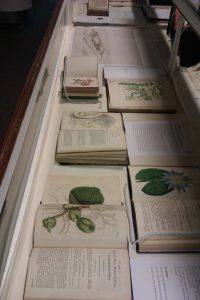The new display in the Library Foyer provides a whistle-stop tour of the history of the Garden with illustrations from the Library and Archive collections of plants that could be found in the Garden at different points during that history . The exhibition also highlights some of the animals that have been associated with the Garden including “Donald”, the last of the Garden’s ponies and “Granny”, the smooth sea anenome that drew visitors to the Garden between 1879 and 1887.
The Garden was founded in 1670, four years before the first cargo of tobacco arrived in Scotland. This was a turbulent time in Scottish history – 15 years after the Garden was founded King James VII of Scotland fled to France leaving his supporters, the Jacobites, to fight for the rights to the throne for James, his son and his grandson, Bonnie Prince Charlie. In 1689, Edinburgh Castle was held for King James by the Duke of Gordon. On the 14th March the Earls of Lothian and Tweeddale issued a verbal demand for its surrender on ‘ane act to Exhoner his grace and other papists there for bygons’. Gordon refused and on the 15th March orders were given ‘to block up the Castle’ forthwith. In April, in what proved to be an unsuccessful attempt to end the siege, orders were given to drain the Nor’ Loch, ‘of design to find out the bottom of the Well of Water that furnishes the Castle’; the water from the Loch flooded the Physic Garden and left behind inches of mud and rubbish from the city drains with the result that “all but the hardiest plants, so patiently collected by Balfour, Sibbald and Sutherland, were practically obliterated”.
In 1763, four years after the birth of Robert Burns, John Hope moved the Garden to a new site on Leith Walk. This was obviously a popular move as just 4 years later the city decided to follow in a similar direction with the foundation stone being laid for the first house in the Edinburgh New Town.
The Garden’s final move, to the current site in Inverleith took place between 1820 and 1823, 13 years after the passing of the Act that abolished the slave trade in Great Britain and 27 years before the birth of Robert Louis Stevenson.
The display can be viewed in the Library Foyer, 20A Inverleith Row, between 10am and 4.30pm, Monday to Friday, from the 30th July until the 4th October 2013.
More information about the history of the Garden can be found on the main RBGE website.

